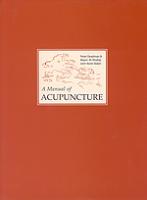Acupuncture and TCM Books
A Manual of Acupuncture (2nd Edition) (Hardcover)
 A Manual of Acupuncture
A Manual of Acupuncture
Check New and Used Prices
by Peter Deadman, Mazin Al-Khafaji, Kevin Baker
Since its publication in 1998 this comprehensive text has rapidly become the standard acupuncture point book for students and practitioners throughout the English-speaking world. Detailed exposition of the names, locations, indications and actions of every point, it is characterised by hundreds of beautiful and anatomically exacting illustrations (one for every point), lengthy commentaries on the points, numerous point combinations drawn from classical texts and comprehensive indexes.
Table of Contents:
The channels and collaterals
Point categories
Point selection methods
Point location and needling
Body area illustrations
Areas reached by the channels
The book is essentially a description of each and every one of the 360 or so primary acupuncture points of Traditional Chinese Medicine. There is a good bit of material about methodology of point selection, but the real gem of this book is the intelligent and thorough descriptions of the points, their properties, and how to locate and needle them. The reason that I gave the book five stars is that it is far more complete and logical in its point descriptions than any of the Chinese texts used by my acupuncturist, a Chinese chiropractor who was a medical doctor Shanghai for eight years before coming to the US and becoming a chiropractor. Often when a discipline is translated from one language and culture to another, the highly systematized translation is more complete and sensible than the eclectic literature corpus upon which it is based. Those who devised this book have created a phenomenally comprehensive synthesis of over 3,000 years of Chinese medical tradition. They have taken on a monumental task and succeeded brilliantly. The quality of this reference is so high that I would even recommend it to practitioners from the orient who are coming to the US or other English-speaking countries to start a practice. First, it will it help them learn the English vocabulary of acupuncture jargon and help them understand our butchered pronunciations of the many Chinese words in an English acupuncturist's vocabulary. Second, they will be able to better communicate their activities to their patients. Finally, the book is as high a quality reference as anything they will have brought with them from Asia.
Students of TCM, don't let the price tag intimidate you, and let me assure you that it is worth every penny. This hefty and handsome volume leaves nothing unsaid, and meticulously provides detailed information, plenty of informative quotes from a wealth of classical sources, and is a joy to handle, browse, and read from. Of particular interest and value are the sections which describe the special point groupings, because they not only provide the lists of points which belong to these categories, but also systematized and coherent explanations behind the workings of cleft-xi, yuan-source, luo-connecting, and many other point categories. Also of great value are the commentaries pertaining to each individual point, because they describe relationships and important pointers regarding the workings of each individual point, how their use and indications developed through history, and other tidbits of information which will open new avenues of investigation and application for astute students and practitioners. The commentaries on the points provide not only information, but are written in a lucid prose, the style of which aids memorization and learning of important information.
The point location information is accurate, albeit in a few cases too brief, in my opinion. The illustrations are very detailed and actually useful (unlike in other texts) in locating the points. The notes and cautions on needling of points in sensitive areas are placed where they are readily visible, and provide information on the local anatomy of the point, and what the consequences of inappropriate insertion could be.
There are charts which show major points per anatomical region (which are actually legible and understandable), and indexes aplenty: pinyin and chinese point names, english point names, and a particularly interesting point indications index. There is also a Glossary of the Wisemanese-seeming terminology used by the authors, which although similar to that of A Practical Dictionary, is not exactly the same.
Should you buy this book? ABSOLUTELY!!! You will never need another acupoint book, EVER. There is a companion set of Point cards by the same authors, which uses the same illustrations and a summary of point information based on the contents of the book. One word of advice, though: if it stays standing on the shelf for too long, the pages tend to sag. However, given the amount of use this book has, that's unlikely to happen.

A Manual of Acupuncture
Check New and Used Prices